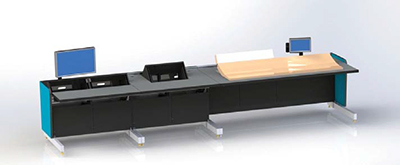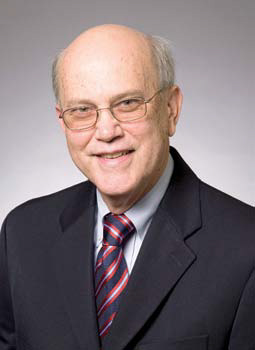NEP Launches ‘Transportable Studio’

NEP’s transportable control room includes chairs and consoles (which NEP dubs “P1”) that can be assembled in up to three rows to accommodate up to 10 technicians and production staff.
PITTSBURGH—From his vantage point at NEP Studios, George Hoover could see the demand for a unique transportable studio increasing. And he and his peers decided now was the time to address a need in the market.
What he and his crew saw was how talk shows, for instance, normally require a permanent studio; others, such as the studio show of a sports all-star game, were of a more temporary nature, and did not require that kind of expense. So what Hoover, NEP’s chief technical officer, and the company are offering what it’s calling the first “transportable control room.”
It will come with several Sony PDW 1500–PDW 2500 cameras that can be shipped to any location in North America and be fully operational, often in less than 12 hours. It also comes with a full complement of state-of-the-art control room equipment to accommodate productions requiring up to eight cameras, making it ideal for smaller or shorter-term television programming that might not have the budget or the need for permanent studio space.
“This new product,” said Hoover, “illustrates the difference between what’s been available in the market for talk shows, news program or the news desk at a political convention, for instance. It can be set up anywhere the client wants more than the usual two or three cameras that the news division normally uses.”
ALL IN ONE
Not only does the transportable control room fill a need; in a way, it creates more available space.
“In many big cities, such as New York and Los Angeles, long-term studio space for productions can, at times, be scarce,” said Barry Katz, senior vice president and general manager of NEP Studios. “The new transportable control room is a direct response to our clients who need a fast and cost-effective solution, and don’t want a long-term studio.
The professional video industry's #1 source for news, trends and product and tech information. Sign up below.
“With this unique transportable solution, we can offer them the capabilities of a permanent control room, complete with consoles and furniture, with the flexibility and efficiency of a fly pack,” Katz added.
While the transportable solution can be customized to include any equipment combination specified by the client, the standard configuration supports productions of six to eight cameras and includes a choice of a Grass Valley Kayak, Kalypso, Karrera or Kayenne switcher; a 48-input Studer Vista 5 audio mixing desk; six-channel DVDRAM recorder and eight DVE systems.
The package also includes a complete Riedel intercom system, an integrated router and a monitor wall that can be scaled and configured to the size and dimensions of the production space. NEP’s transportable control room also includes chairs and consoles that can be assembled in up to three rows to accommodate up to 10 technicians and production staff.
BUDGET FRIENDLY
A shift in the market is what’s making the transportable control room viable in today’s market, Hoover said.
“There is a great deal of ‘shoulder programming’ today,” he said, pointing to “the best recent example,” a pilot that was shot last year with an indie production company that featured Kris Jenner. “It was a summer replacement talk show with a short lead time. We had to move ‘The Ricki Lake Show’ from another facility to make the production work, which is what illustrated the need to offer certain capabilities—on short notice—for a potentially long-term project.

George Hoover “The producers of the Jenner pilot took six months putting it together. We could have even forgone building a permanent set, by making that temporary control room permanent and setting up another one,” said Hoover, adding, “No one on the Jenner project would have sacrificed comfort or technical capability.”
Nor did they overspend. “These [transportable control rooms] are also very economical. By the time it’s equipped with six to eight cameras, renting them runs a couple of million dollars. They are scalable, too, so you can build out to a certain degree.”
For many projects, it’s a no compromise solution. “It can be economical, even for very short productions of a day or two, when there is only a certain amount of space, like in an office building or a restaurant,” Hoover said. “This is just one more tool for a producer.”
ALMOST READY
Hoover said that NEP also still offers about a dozen flypack systems worldwide that range from two to 30 cameras that are “truly” flypacks. “We put them on a plane and they can be sent anywhere in the world,” he said. “They’re rugged and meant for that kind of an atmosphere,” adding that they’ve recently been used in Sochi, London, and soon will be used at the Commonwealth Games in Glasgow.
But NEP found that its clientele wanted a more sophisticated product that a production would be comfortable with during a multiday, week or monthlong shoot. So it’s starting by building one portable system and “will see how the market goes,” he said.
“We may work up to offering three or four, over time,” he said. “This one will be based in the U.S., but we may eventually have others in London or Sydney. We’ll send it wherever we can get it where it needs to go, while keeping the shipping costs as low as possible.
And what’s the market, so far? “We have three pilots that may rent it this summer,” Hoover said. “We want the first room to be finished right after NAB.”
Mark R. Smith has covered the media industry for a variety of industry publications, with his articles for TV Technology often focusing on sports. He’s written numerous stories about all of the major U.S. sports leagues.
Based in the Baltimore-Washington area, the byline of Smith, who has also served as the long-time editor-in-chief for The Business Monthly, Columbia, Md., initially appeared in TV Technology and in another Futurenet publication, Mix, in the late ’90s. His work has also appeared in numerous other publications.

